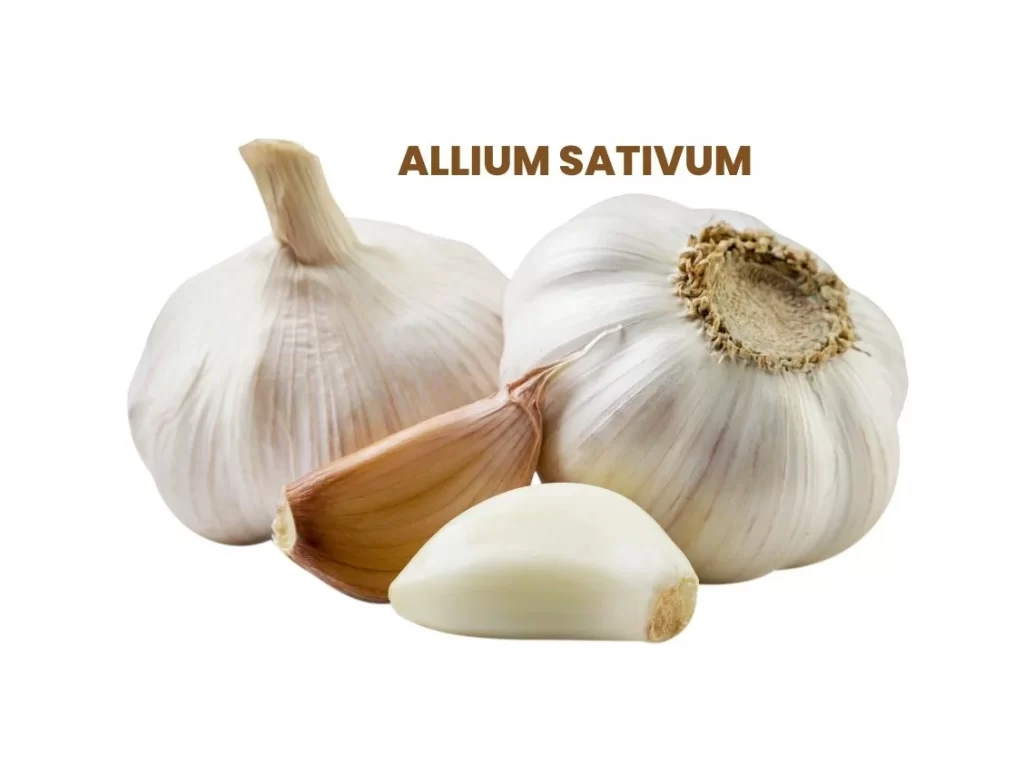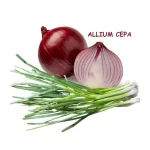Allium Sativum, commonly known as Garlic, is a potent homeopathic remedy derived from the bulb of the garlic plant.
Garlic has been used for various medicinal purposes for centuries, and its homeopathic preparation, Allium Sativum, harnesses its therapeutic properties in a highly diluted form.
Allium Sativum demonstrates its adaptability by addressing a range of symptoms, from gastrointestinal and cardiovascular issues to musculoskeletal and respiratory conditions.
Its ability to influence blood pressure and circulation, along with its impact on digestion and respiratory functions, makes it a versatile remedy in homeopathic practice.

Table of Contents
ToggleSOURCE INFORMATION
- Botanical Name: Allium sativum
- Common Name: Garlic
- Family: Amaryllidaceae
- Part Used: Bulb (cloves)
Garlic is a perennial plant that belongs to the onion genus Allium.
It is characterized by its pungent aroma and distinctive taste.
The plant produces underground bulbs consisting of individual cloves.
Geographic Origin: While garlic is now cultivated worldwide, its exact origin is believed to be in Central Asia. It has a long history of cultivation and use in various cultures.
Culinary and Medicinal Use: Garlic has been widely used both as a culinary ingredient and for its medicinal properties.
It is known for its strong flavour and is a common ingredient in many cuisines.
Medicinally, garlic is renowned for its potential cardiovascular benefits and immune system support.
Active Compounds: Garlic contains sulfur compounds, including allicin, which is considered a major bioactive component.
Allicin is formed when garlic is crushed or chopped and is associated with various health-promoting effects.
Traditional Uses: Throughout history, garlic has been used for its antibacterial, antiviral, and antifungal properties.
It has also been employed to support respiratory health, boost the immune system, and regulate blood pressure and cholesterol levels.
CHIEF GUIDING SYMPTOMS
- Gastrointestinal Effects
- Allium Sativum acts directly on the intestinal mucous membrane, stimulating peristalsis, which aids in digestion and bowel movements.
- It is particularly beneficial in cases of colitis, especially when there is an imbalance in the normal gut flora.
- Vasodilatory Properties
- Garlic exhibits vasodilatory effects, which can help in improving blood flow and reducing arterial tension.
- Cardiovascular Conditions
- Arterial hypotension, characterized by low blood pressure, may improve within 30 to 45 minutes after taking twenty to forty drops of the tincture.
- Constitutional Affinities
- Allium Sativum is well-suited for individuals who are fleshy and may experience dyspepsia (indigestion) and catarrhal (mucous) affections.
- It is indicated for “high livers,” referring to those who consume a significant amount of food, especially meat, relative to their fluid intake.
- Musculoskeletal Symptoms
- Pain in the hip, psoas (muscle located in the lumbar region of the lower back), and iliac muscles may find relief with Allium Sativum.
- Respiratory Conditions
- Allium Sativum is beneficial for conditions like pulmonary tuberculosis.
- Symptoms such as coughing and expectoration (coughing up of mucus) may diminish with its use.
- Improvement in temperature regulation, weight gain, and sleep patterns may be observed.
- Haemoptysis
- It is indicated for haemoptysis, which refers to the coughing up of blood from the respiratory tract.
PARTICULARS
Head
- Feeling of heaviness; pulsating sensation in the temples; catarrhal deafness.
Mouth
- Increased production of sweetish saliva after meals and during the night.
- Sensation of a hair on the tongue or throat.
Stomach
- Excessive appetite; burning eructations (burping).
- Any slight change in diet leads to gastrointestinal issues.
- Constipation accompanied by persistent dull pains in the bowels.
- Pale tongue with red papillae (taste buds).
Respiratory
- Persistent rattling of mucus in the bronchial tubes.
- Cough occurs in the morning after leaving the bedroom, with thick mucus expectoration that is hard to clear.
- Sensitivity to cold air.
- Bronchial tubes become dilated, producing fetid expectoration.
- Sharp, shooting pain in the chest.
Female
- Pain in the swelling of the breasts.
- Eruption (skin rash) occurs in the vagina, breasts, and vulva during menstruation.
RELATIONSHIP
Allium Sativum (Garlic), as per Dr. Teste, is grouped with Bryonia, Lycopodium, Nux Vomica, Colocynthis, Digitalis, and Ignatia.
These remedies deeply affect individuals who consume flesh-based diets, showing less impact on vegetarians.
Therefore, these remedies are particularly applicable to meat eaters rather than strict vegetarians.
Comparison: Capsicum; Arsenicum; Senega; Kali nit.
Complementary: Arsenicum.
Antidote: Lycopodium.
DOSAGE
- Third to sixth potency.
- In tuberculosis, a dose of four to six grams in a moderately dehydrated state daily, divided into multiple doses.
FREQUENTLY ASKED QUESTIONS
What is Allium Sativum, and how is it prepared in homeopathy?
- Allium Sativum, commonly known as Garlic, is a homeopathic remedy derived from the bulb of the garlic plant. It is prepared in a highly diluted form to harness its therapeutic properties.
What is the source information for Allium Sativum?
- Botanical Name: Allium sativum
- Common Name: Garlic
- Family: Amaryllidaceae
- Part Used: Bulb (cloves)
- Garlic, a perennial plant, is cultivated worldwide and has a long history of culinary and medicinal use.
What are the chief guiding symptoms of Allium Sativum?
- Allium Sativum addresses a range of symptoms, including gastrointestinal effects, vasodilatory properties, cardiovascular conditions, and musculoskeletal and respiratory symptoms.
- Notable constitutional affinities include its suitability for fleshy individuals with dyspepsia and catarrhal affections.
How does Allium Sativum affect the gastrointestinal system?
- Allium Sativum acts directly on the intestinal mucous membrane, increasing peristalsis.
- It is beneficial in cases of colitis with pathological flora, promoting digestive health.
What are the cardiovascular effects of Allium Sativum?
- Allium Sativum exhibits vasodilatory properties, potentially improving blood flow and reducing arterial tension.
- It may address arterial hypotension within 30 to 45 minutes.
Who is Allium Sativum suitable for?
- Allium Sativum is adapted to fleshy subjects with dyspepsia and catarrhal affections.
- It is indicated for “high livers,” individuals who consume more food, especially meat, than they drink.
What musculoskeletal symptoms does Allium Sativum address?
- It is beneficial for pain in the hip, psoas, and iliac muscles, providing relief to individuals experiencing discomfort in these areas.
How does Allium Sativum affect respiratory conditions?
- Allium Sativum is indicated for pulmonary tuberculosis, and it may reduce cough and expectoration, normalize temperature, aid in weight gain, and improve sleep patterns.
What is haemoptysis, and how is it related to Allium Sativum?
- Haemoptysis refers to the coughing up of blood from the respiratory tract.
- Allium Sativum is indicated for this condition, suggesting its potential role in addressing such symptoms.
How is Allium Sativum related to other homeopathic remedies?
- According to Dr. Teste, Allium Sativum belongs to the Bryonia group, which includes remedies like Lycopodium, Nux Vomica, Colocynthis, Digitalis, and Ignatia.
- These remedies are noted for their impact on individuals who consume flesh-based diets.
What is the recommended dosage for Allium Sativum?
- The recommended potencies range from third to sixth. In tuberculosis, a daily dose of four to six grams in a moderately dehydrated state is advised, divided into multiple doses.













Leave a Reply